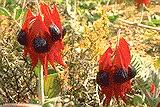|
[Front Page] [Features] [Departments] [Society Home] [Subscribe]

Favourites - 2
Contributions from readers are invited for this series on their favourite species, cultivar, hybrid or plant group. You don't need to write much - three or four paragraphs would be fine! So, if you'd like to give it a go, please get in touch with the editor (sgap@ozemail.com.au). If you have a good colour photograph to accompany it, that would be great but, if not, we may be able to dig up one from somewhere!
Growing Sturt's Desert Pea in the UK
Norman Wells
The first difficulty you are likely to encounter with this plant is that of deciding what to call it. It rejoices in a variety of names including: Clianthus speciosus, Swainsona formosa, Clianthus formosus, Willdampia formosa, the Glory Pea and Sturt's Desert Pea. For the purpose of this article let us simply call it SDP. It will save on the typing - and the file size.
The second difficulty you are likely to encounter is the large variations in descriptions of how to grow it in this country. Yes it can be, and is grown in this country. Raymond Foster in his book "The gardener's guide to rare and exotic plants" lists it as growing wild, in the open, in the Scilly Isles. All sources list it as a difficult plant to grow. The site offered by ASGAP gives a very comprehensive view of the plant and is well presented.
My interest in growing the plant is firstly, the challenge. In an area far removed from the tropical heat of Australia it would certainly not be in anything nearing its natural habitat. Secondly, this is a spectacular plant by any standards and well worthy of being the emblem of South Australia. Finally as a reminder of my visit to your country where, at the invitation of Dr Peter Boon, we traveled the Stuart Highway from Port Augusta to Darwin and were privileged to see at first hand the many wonderful wild plants that Australia possesses.
 |
Despite is difficulties, the spectacular flowers of Swainsona formosa make this a popular plant for cultivation.
Select the thumbnail image or highlighted name for a higher resolution image (43k).
|
As previously stated I researched the various names for the plant existing in publications and received much conflicting information. Clearly the directions on the seed packets bought in Darwin, could not apply here and it was necessary to re-think the whole exercise. This article is written as a record of that experience with the hope that it might be of help to other growers interested in this plant.
The first requisite of growing any plant is to provide it with the conditions in which it normally flourishes. So in West Yorkshire you are going to have a problem! There are three main problems which confront the grower in this country. They are:
- heat (or lack of it),
- light, and
- soil conditions.
I include weather in both of the first two.
Heat
The weather in Britain of recent years has shown a marked change. Gone are the cold winters with snow and frost for days on end. We have had no lasting snowfall in this area for over four years and had virtually not frost last winter.... indeed I now leave gladioli and agapanthus in the ground, all year round. There has, however, been a marked increase in rainfall with substantial flooding in some parts of the country and also a noticeable increase in the number, and intensity, of windy days. Summers, at best unpredictable in England, have varied from severe drought conditions to dark and overcast.
We are fortunate, however in having a conservatory attached to the house and from February onwards temperatures of 80 degrees (F) and above are common - when the sun shines! The aspect is south-facing and has full sun for most of the day. One of the problems of such a position is finding plants which can cope with such temperature variations. The number of tropical and sub tropical plants do not like full sun is amazing. Temperatures in a conservatory in England are therefore likely to be able to sustain plants of this kind provided that they are either heated or south-facing conservatory. My position is unheated.
Light
Light levels in this part of the world are poor. The number of overcast days is significant and rain in both winter and summer is abundant in normal years. Taking photographs of my daughter's graduation two weeks ago caused the automatic flash to trigger outside - at noon!. It has to be said that that was in Manchester, which is a different world! Light levels were therefore a factor in my thoughts in growing this plant.
Soil conditions
The normal soil conditions in this part of the world are a medium to heavy loam overlaying heavy yellow clay at about a depth of one foot. Not exactly the conditions for SDP.
 |
Rarely cultivated, the white form of Swainsona formosa makes an interesting contrast with the more typical form.
Select the thumbnail image or highlighted name for a higher resolution image (33k). Photo: Michael Tutt
|
Growing method
With so much conflicting information the only thing I could do was to experiment within the known area conditions of the plant. Accordingly I soaked seed in hot water (not boiling) overnight and observed the signs of swelling. From those I selected six seeds to bring on under different conditions. They would have to be grown as conservatory plants not so much because of the heat problem but because the plant is susceptible to rot if exposed to rain. It is not only heat it requires but also dry conditions, at least in the upper parts. Of the plants which were planted in pots, two have remained viable and are now flowering.
All the sources of information indicated the use of sand in the growing medium. Experience in my case has shown that it depends what you mean by sand. Clearly the granule size of sand varies and the smaller grained variety compacts readily. The best growing medium for my group turned out to be a mixture of 50% John Innes No 2 and 50% grit sand. The granules in grit sand are variable in size and provide an open mixture which enables easy root penetration. Granule size goes from 1mm to 5mm.
I formulated the opinion that the plant operated in the following way.....
Its prime purpose on germination is to find water. In Australian conditions this will be at some depth following rain which penetrates open soils easily. Observation of failures showed a strong downward root. A deep pot is therefore required, (at least one foot deep). Unfortunately, in this country, if you want depth of pot you have to buy a wide one. All plants in plastic pots perished and best results were obtained in unglazed, terracotta pots. I consulted a potter who advised me that some terracotta pots do, in fact, have a thin glaze on them, although this is not always apparent. The way to test this is to wet a finger and apply it damp to the pot. An unglazed pot will readily absorb the moisture while a glaze will provide a barrier to penetration.
In order to mimic Australian conditions, the pot was stood on a wide, deep dish containing gravel. Watering was affected by watering the gravel keeping it moist at all times. Root penetration of the gravel is substantial and once established the plant and its attendant dish should be treated as one unit when lifting, in order to minimise root disturbance. Indications are that once it reaches water it then transports it up the root dissolving nutrients on the way. Thus watering from the top will affect the ability of the plant's own natural system of sustenance.
Conclusions
Plants of this genus can be grown successfully in British conditions. They need to be treated as conservatory plants and grown in a free draining, easily penetrated medium of potting compost and medium grained aggregate. Watering is best from the bottom and to facilitate this standing on aggregate and keeping this moist has been found most effective.
Future developments
I intend to over-winter the plants and observe their development. Temperatures in the conservatory are kept relatively high due to borrowed heat from the house. Next spring I intend to plant more seed this time using a wide bore terracotta land drain piping from the local builders' merchant. Not all terracotta is permeable but a drainage pipe should meet the need. I intend to site the pipes, end up, on a gravel bed. One plant will be grown in a pot but this time I will drill additional holes in the bottom of the pot with masonry drill to facilitate root penetration and drainage.
Note: Norman sent several photographs of his plant to demonstrate that he has indeed successfully met the challenge of growing Sturt's desert pea in the UK. Unfortunately the photos did not scan sufficiently well to include with this article.

[Front Page] [Features] [Departments] [Society Home] [Subscribe]
Australian Plants online - September 2000
Association of Societies for Growing Australian Plants
|